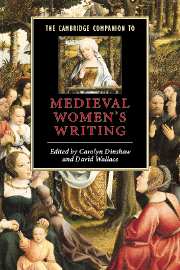6 - Women and authorship
from Part II - Texts and other spaces
Published online by Cambridge University Press: 28 May 2006
Summary
Were there women authors in the Middle Ages? The answer depends on which term we consider to be in question, 'women' or 'author'. The burden of proof has long rested on the former, following the assumption that medieval authors were exclusively men. Accordingly, nearly every major work believed to have been written by a medieval woman - including the letters of Heloise, The Book of Margery Kempe, and many works by Christine de Pizan - has at various times been attributed to a male author. More recently, however, the term 'author' itself has come into question, as some scholars have asked whether authorship - at least in its familiar, modern sense - could be said to have existed in the Middle Ages at all. The author holds a privileged status in literary studies; more than simply a work's writer, the author carries an ideological function as the figure around whom ideas about literary tradition, authority, and creativity are organized. Yet what counts as an author has been historically variable.1 The idea that authors were the sole originators of their texts is a relatively recent one, supplanting earlier models that invested those origins in divine or historically remote sources; likewise, the modern idea of the author as a single, creative individual holds limited relevance for medieval textual culture, in which many texts were collaborative, anonymous, or adopted as common property. Those who study literature by medieval women find themselves facing a critical quandary: is it possible to speak of medieval women authors if the ‘author’ did not exist in the Middle Ages?
- Type
- Chapter
- Information
- The Cambridge Companion to Medieval Women's Writing , pp. 91 - 108Publisher: Cambridge University PressPrint publication year: 2003
- 9
- Cited by



